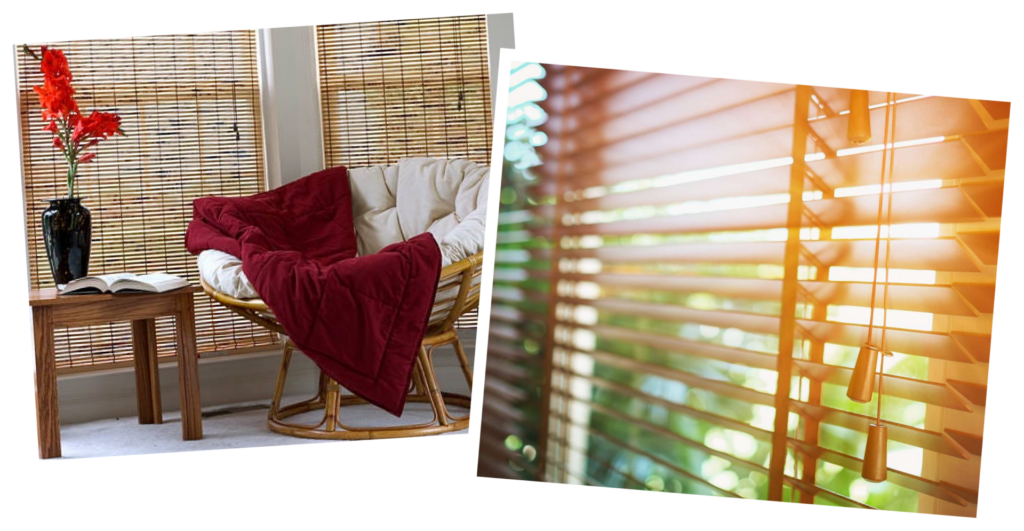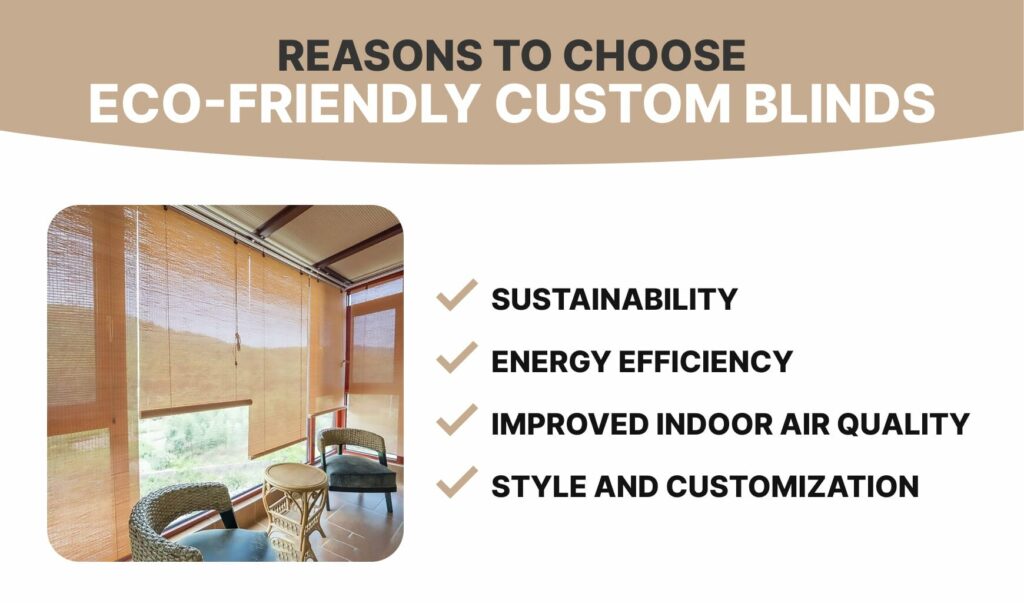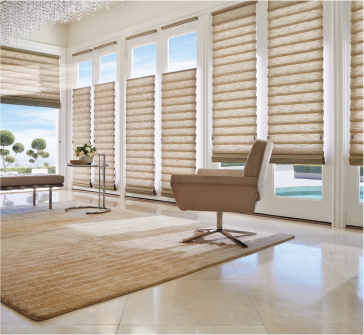Going green is more important than ever. Everyone, including our homes, is trying to minimize our footprint on the planet. While window treatments may be the unsung heroes of home décor and function, you may not have realized that some blinds, shades, and other window treatments are produced using potentially toxic chemicals or parts.
Fortunately, there is a wide range of increasingly available sustainable custom blinds that provide all the look and operation of conventional window treatments.
In this blog, we’ll look at the advantages of sustainable custom blinds and guide you toward the best choice for your needs.

What are Eco-Friendly Custom Blinds?
Eco-friendly or sustainable custom blinds may be produced using materials that are less harsh on the environment and made from renewable or recycled resources like bamboo, cork, or wood. This lessens the demand on non-renewable resources and decreases waste.
Besides that, many such window treatments have superior energy-efficient qualities. Cellular shades, for instance, provide pockets of air that insulate and keep indoor temperatures consistent. This can cut down on energy used to heat and cool your home and lower your electric bills as well as your energy footprint.

Why Choose Eco-Friendly Custom Blinds?
There are several compelling reasons to choose eco-friendly custom blinds for your windows.
Sustainability
Eco-friendly blinds are made from renewable or recycled materials like bamboo, cork, or wood. This reduces reliance on virgin resources and minimizes waste.
Energy Efficiency
Many eco-friendly blinds boast excellent insulating properties. Cellular shades, for example, trap air pockets that help regulate indoor temperatures. This can significantly reduce your energy consumption for heating and cooling, leading to lower utility bills and a smaller carbon footprint.
Improved Indoor Air Quality
Dust, pollen, and allergens can accumulate on some conventional blinds and shades. Sustainable custom blinds made from natural materials tend to contribute to better indoor air quality. This is particularly beneficial for those with allergies and respiratory conditions.
Style and Customization
Sustainable custom blinds are better for the earth and can be very good for your style sensibilities. They come in many different materials, hues, and textures to fit any décor. And, as with any custom blinds, you can size them precisely for your windows.

Popular Eco-Friendly Blind Options
Here’s a look at some of the most popular eco-friendly blind options available:
Cellular Shades
One of the most popular shades for the environmentally minded is this blind with built-in air pockets or “cells.” Trapped air insulates and offers superior energy efficiency. You can find cellular shades in many different materials including recycled polyester and natural woven fabrics.
Bamboo Blinds
Bamboo is a rapidly growing renewable resource that produces an attractive sustainable blind. Bamboo blinds have a natural look and are available in several colorations. They’re durable and moisture-resistant too.
Wood Blinds
When wood blinds come from well-managed forests and have non-toxic stains and paints, they’re a sustainable custom blind. They bring classic style to any décor and have superior light-filtering abilities.
Woven Wood Shades
The natural materials from which woven wood shades are fabricated including bamboo, reeds, or grasses make this a visually appealing sustainable option. They filter soft light and add interesting texture to windows.
Recycled Content Blinds
Many companies produce blinds and mini blinds that include recycled materials like plastic bottles or wood scraps. You can refresh your windows and your home décor with sustainably made blinds without compromising style or quality.
Additional Considerations When Choosing Eco-Friendly Blinds
In addition to the types of materials from which they’re made, here are other things to look for in sustainable blinds:
- Local manufacturing: By purchasing locally made blinds you’re supporting your community and avoiding transportation fuels which add to carbon emissions.
- Minimal packaging: Some window treatments have recyclable or little packaging. This lessens waste that ends up in landfills.
- Durability: Well-constructed blinds that endure and require fewer replacements over your lifetime reduce the demand for sustained manufacturing and disposal.
Eco-Friendly Considerations for All Blinds and Shades
Even if you don’t choose fully eco-friendly blinds, there are still ways to be more sustainable with your window treatments:
Even if you don’t purchase fully sustainable custom blinds, you can still be eco-conscious in several ways when it comes to blinds and shades:
- Take good care of your blinds: By cleaning and maintaining blinds as per their proper and adequate care guidelines you can prolong their lives and reduce disposal.
- Open those blinds: Whenever possible, use natural light instead of electrical lights.
- Reuse and repurpose: Have old blinds? Think about repainting them or reusing them for a different application.
Eco-Friendly Blinds are Great for Apartments
While eco-friendly considerations are important for any homeowner, they are some of the best blinds for apartments. Many apartment buildings have restrictions on window treatments, such as size, color, or material limitations.
The good news is that many eco-friendly blind options, such as cellular shades, transitional shades, and bamboo blinds, are also ideal for apartments. These blinds are often lightweight, easy to install, and come in neutral colors that complement various décor styles.

Function & Sustainability: The Latest in Blind Trends
Staying on top of the latest blind trends allows you to choose eco-friendly and fashionable options. Here are a few popular ones to consider:
Smart Blinds
Smart blinds integrate with home automation systems, allowing you to control light and temperature remotely. While not all smart blinds are eco-friendly, some are made with sustainable materials and offer energy-saving features.
Natural Textures
Blinds made from natural materials like bamboo, woven wood, or linen are popular trends that perfectly complement organic and minimalist aesthetics. These materials offer a warm, inviting feel and pair well with other natural elements in your home.
Motorized Blinds
Motorized blinds offer convenience and ease of use, especially for hard-to-reach windows. Look for motorized blinds with energy-efficient motors to minimize their environmental impact.
Blackout Blinds
Blackout blinds are a great choice for bedrooms or media rooms as they completely block out light. Eco-friendly blackout blinds are available in various materials, including recycled polyester fabrics with a blackout lining.
Eco-Friendly Blind Design is On the Rise
Eco-friendly custom blinds offer a win-win situation for your home and the planet. They provide style and functionality, are energy efficient, and minimize environmental impact. Considering the factors discussed in this blog post, you can make informed choices about your window treatments and create a beautiful, sustainable space you’ll love.

